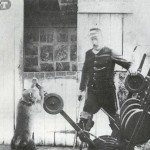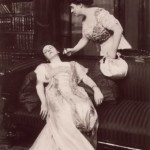Weekly Wrap Volume 87
The word “doughnut” is American in origin and traces its roots to the early 19th century. It is presumed to have been a combination of the words dough and nut. It first appeared in print in Washington Irving’s 1809 Knickerbocker’s History of New York “Sometimes the table was graced with immense apple-pies, or saucers full of preserved peaches and pears; but it was always sure to boast an enormous dish of balls of sweetened dough, fried in hog’s fat, and called doughnuts…” (more)
 Working for Figurative Peanuts and Literal Beer, the Fascinating Story of Jack the Signal”man”
Working for Figurative Peanuts and Literal Beer, the Fascinating Story of Jack the Signal”man”
For most people, saying “a monkey could do my job” is a roundabout way of saying that their current position of employment isn’t exactly that mentally taxing. For James Wide though, it was more of a statement of fact because for 9 years in the late 19th century, his job of railroad signalman at Uitenhage station in South Africa was literally done by a chacma baboon called Jack. Jack came to prominence thanks to a tragic event in 1877 when his eventual owner, James Wide, lost both of his legs in a horrific accident. Prior to the accident, Wide had worked for Cape Government Railways as a guard. During his tenure as a railway guard, Wide developed a knack for jumping between and onto moving trains, which… (more)
 Half a Truck and the Chicken Tax
Half a Truck and the Chicken Tax
Ever wonder why if you want to buy a truck in the United States you have drastically fewer selections than many other countries tend to enjoy and why U.S.-made trucks dominate the market in the country, while the same ratios aren’t seen at all in cars? It’s all because of chickens. No, really. Before the twentieth century, chicken wasn’t nearly as common of an item on people’s dinner plates as today and was very much a luxury item mostly restricted to the wealthy in Europe. (In fact, chickens were actually originally domesticated for cock-fighting, not food.) Improvements in food storage via refrigeration (see: Why Chicken Goes Bad So Quickly), refinements in chicken breeding, and the development of the so called “factory chicken” helped… (more)
 The Dog Who was an Official Prisoner of War
The Dog Who was an Official Prisoner of War
In 1936, the crew of the British gunboat HMS Gnat lacked a mascot, and the captain and crew decided to remedy that situation before starting patrols on the Yangtze River. Their sister gunboats, the Bee, Cicada, and Cricket already had mascots of their own. So Lieutenant Commander J. Waldergrave and Chief Petty Officer Charles Jefferey purchased an English Pointer puppy they named Judy from a kennel in Shanghai, China, intending for her to both serve as mascot and as a gundog for hunting when the crew went ashore. The ship’s cook, Jan “Tankey” Cooper, was assigned the responsibility of caring for her. Fast-forward to the start of WWII and the HMS Gnat was recalled to port where Judy joined the crew members who transferred to the HMS Grasshopper in June of 1939. Three years later… (more)
 Thor Heyerdahl and the Kon-Tiki
Thor Heyerdahl and the Kon-Tiki
Thor Heyerdahl was born in Larvik, Norway on October 6, 1914. His father worked as a brewer while Heyerdahl’s mother held a leadership position at a local museum. Heyerdahl spent his childhood trekking through the forest at the edge of town and then climbing mountains with his pet husky. Despite those adventures, he only learned to swim in his twenties- nearly drowning twice when he was young led to an understandable fear of water until then. After studying geology and zoology at the University of Oslo, Heyerdahl embarked on a yearlong stay (1937-1938) on an island in the South Pacific called Fatu Hiva. The trip served the dual purpose of giving Heyerdahl the opportunity to study the local flora and fauna while also serving as a honeymoon with his new wife, Liv Coucheron… (more)
This Week’s YouTube Videos:
- High Crime Vatican City… and 7 other Amazing Facts
- Police Officers and the Color Blue
- The Coming Banana Apocalypse
- The First Car Accident
- A Man Once Tried to Raise His Son as a Native Speaker in Klingon
- The Man Who was a Dwarf and Later a Giant
- Why we call the Seasons Summer, Autumn, Winter and Spring
- Why Do We Toast Drinks?
- The Real Life George Bailey
Bonus Quick Facts:
- Humans enjoy five or more different tastes namely: sour, bitter, salty, umami (associated with meat), and sweet. We can taste sweet things thanks to two proteins generated by two separate genes. Cats, on the other hand, have a mutant chemoreceptor in their taste buds that prevents them from tasting sweet things, which is a trait shared by all cats big and small, not just domestic ones.
- We’ve all heard of Yahoo and have probably seen their commercials and heard the famous yodel “Yahoooooo!” The famous yodel comes from Wylie Gustafson. He made the yodel for Yahoo in 1996 for a one time payment of $590 U.S. Dollars. However in 2002, I guess he wanted more, so he sued Yahoo, settling out of court for an undisclosed amount.
- U.S. President Thomas Jefferson was never a fan of formal affairs, and was often reported to have worn his pajamas while meeting with Foreign dignitaries. For instance, when meeting with British Minister to the U.S., Andrew Merry, he wore his PJ’s. Needless to say, Andrew Merry was not amused and he was later quoted as saying, “I, in my official costume, found myself at the hour of reception he had himself appointed, introduced to a man as president of the United States, not merely in an undress, but actually standing in slippers down to the heels, and both pantaloons, coat and under-clothes indicative of utter slovenliness and indifference to appearances, and in a state of negligence actually studied.”
- If you were to go to Australia and get a craving for food from Burger King, you’ll have to go to a fast food chain called “Hungry Jack’s”. This is because, when Burger King first decided to expand their franchise to Australia, they found out that there was already a food chain there called “Burger King”. This forced them to choose a different name and “Hungry Jack’s” is what they came up with.
- We all know George Armstrong Custer as “General Custer”. However, he was only a General for a brief period after being given a field promotion at the age of 23 to “Brigadier General” from “Captain”, shortly before the battle of Gettysburg. Needless to say from the timing of the promotion, he didn’t keep this rank long; after the war, he was given back his rank of “Captain”. At the time of his death, he was ranked at Lieutenant Colonel.
- Just three months after his death, Charlie Chaplin’s body was stolen on Christmas day in 1977. They thought they could get money from his family in exchange for his body. However, the two grave robbers were captured and eleven weeks later, Chaplin’s body was recovered. To stop this from happening again, Chaplin was buried under 6 feet of concrete the second time around.
Other Interesting Stuff:
 Napoleon and the Invention of Margarine
Napoleon and the Invention of Margarine
Odds are you probably have a stick or a tub of it sitting in your fridge right now, but do you have any idea how margarine became a staple in most kitchens? It turns out, margarine has a long and controversial international history, and can even boast the involvement of Emperor Napoleon III in its invention. Margarine derives its name from a discovery in a chemist’s lab in France in 1813. Scientist Michel Eugène Chevreul uncovered a new fatty acid that he decided to call “acide margarique.” His discovery consisted of shiny, pearl-like deposits, so margarites seemed an apt name, as it is the Greek word for “pearly.” Several decades later, Napoleon III… (more)
 CPR Does Not Require “Mouth To Mouth”
CPR Does Not Require “Mouth To Mouth”
Myth: Proper CPR technique should include frequent use of “mouth to mouth” in between compressions. In fact, the 2010 guidelines set out by the American Heart Association (AHA) do not recommend breathing for someone while performing CPR (and not for your health, as you might think, but for the person experiencing cardiac arrest’s chances of survival). If you’re a person who was trained in CPR a long time ago, you might be familiar with the once staple “15 chest compressions then 2 breaths”. If you followed the 2005 guidelines, then you’re familiar with the “30 compressions then 2 breaths” technique. In both cases, you should throw those out the window. In 2010, ILCOR (International Liaison Committee on Resuscitation), reviewed hundreds of studies and found that breathing just wasn’t necessary for people… (more)
 Why Women Fainted So Much in the 19th Century
Why Women Fainted So Much in the 19th Century
Dropping like flies (or at least as far as many stories indicate), it seems as if well-bred ladies in the 1800s struggled to maintain consciousness when faced with even the slightest emotional or physical shock. Over the years there have been several theories as to why this seemed to happen, from the women’s garb to simply conforming to societal expectations. To begin with, throughout the 19th century (among other times), ladies often wore corsets. Worn around the torso, corsets were made of a durable tightly woven fabric or leather, fashioned with channels running throughout them in which vertical ribs were inserted, called boning because they were often made with whale bone (although ivory… (more)
 The Man Who Created James Bond Also Wrote Chitty Chitty Bang Bang
The Man Who Created James Bond Also Wrote Chitty Chitty Bang Bang
The man was Ian Fleming. Born May 28, 1908 to a wealthy family in London, he and his three brothers were educated at Eton College, the same school Princes William and Harry attended. Fleming was supposedly a master of athletics. After Eton, he attended Sandhurst and chose to study in Munich and Geneva, where he had the Alps as a backdrop. He would later learn to ski and climb the mountains, perhaps not surprising given his athletic history, which would also set the stage for some of his yet-to-be-conceived character in the James Bond books. Fleming jumped from career to career almost as often as he switched girlfriends. He was known to be a “womaniser,” not that the ladies seemed to mind—apparently they thought him very attractive. In this way, he didn’t differ much from Bond himself. He first tried to establish himself in the military, followed by an attempt to become a foreign diplomat—both were unsuccessful… (more)
When we say the word “sugar”, it’s highly likely that the first image to pop into your head is that of the ultra-fine, pure white granulated kind you can buy in most supermarkets. But how does this kind of sugar differ from the less popular brown kind, and why isn’t it as prone to forming into lumps as its dusky cousin? To properly answer this question, we’ll first delve into how sugar (as in common table sugar, rather than other short-chain, sweet, soluble carbohydrates) is produced in the first place, because it’s key to understanding how the white variety differs from brown sugar and why the latter often lumps together. Beyond that, it’s also just interesting. As you’re probably aware, the common sugar you buy in stores is primarily derived from… (more)
Gray hair, memory loss, wrinkles and brittle bones, sooner or later, each of us gets old (if we’re lucky). Yet scientists tell us that there is no evolutionary reason for us to age. So, why do we? The Aging Process: Researchers do not agree as to the causes of aging. Some claim our genes are programmed to deteriorate, wither and die, while others believe accumulated damage is the root of our senescence. Muddying the waters further, many believe that a combination of several factors contributes to aging. Cell Damage: Around since 1882 when biologist August Weismann first introduced it, at its fundamental level, the cell damage theory holds that the body succumbs to… (more)
| Share the Knowledge! |
|







